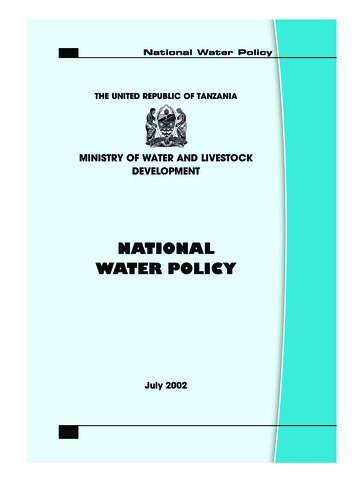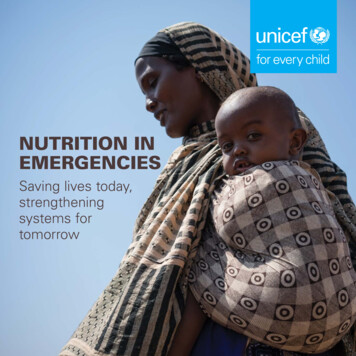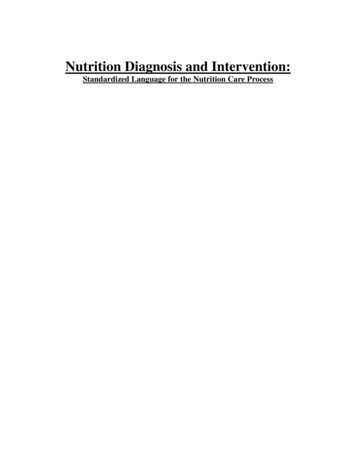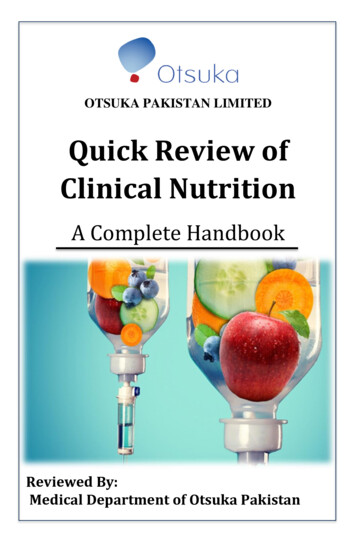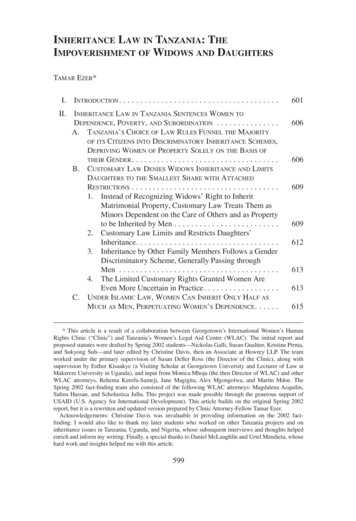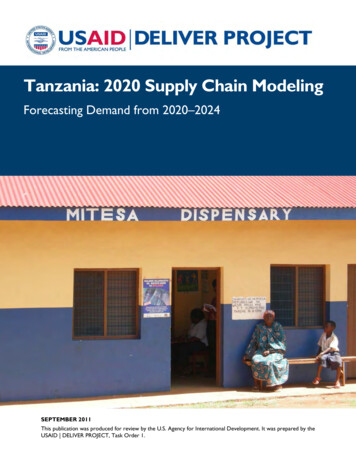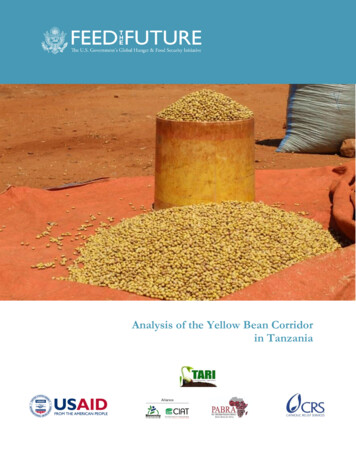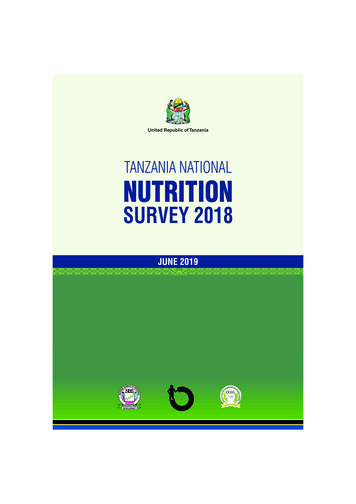
Transcription
United Republic of TanzaniaTANZANIA NATIONALNUTRITIONSURVEY 2018JUNE 2019
United Republic of TanzaniaTANZANIA NATIONALNUTRITIONSURVEY 2018JUNE 2019Tanzania National Nutrition Survey 2018i
TANZANIA NATIONALNUTRITION SURVEY 2018FINAL REPORTThis survey was possible thanks to technical and financial support from the following partners: iiTanzania National Nutrition Survey 2018
Additional information about 2018 TNNS may be obtained from Dr. Vincent D. Assey, ManagingDirector, Tanzania Food and Nutrition Centre, 22 Barack Obama Drive, P.O. Box 977, Dar es Salaam.Telephone: 255 22 2118137, Fax: 255 22 2116713, Email: info@tfnc.go.tz; the National Bureau of Statistics, Head Office, Jakaya Kikwete Road, P.O. Box 2683, Dodoma. Telephone: 255 26 2963822, Fax: 255 26 2963828, Email: sg@nbs.go.tz; and Fanny Cassard, SMART Survey Consultant – Nutritionist,Email: fcassard@gmail.comISBN 978-9976-910-86-5Recommended Citation:Ministry of Health, Community Development, Gender, Elderly and Children (MoHCDGEC) [TanzaniaMainland], Ministry of Health (MoH) [Zanzibar], Tanzania Food and Nutrition Centre (TFNC), National Bureau of Statistics (NBS), Office of the Chief Government Statistician (OCGS) [Zanzibar] and UNICEF. 2018.Tanzania National Nutrition Survey using SMART Methodology (TNNS) 2018. Dar es Salaam, Tanzania:MoHCDGEC, MoH, TFNC, NBS, OCGS, and UNICEF.Tanzania National Nutrition Survey 2018iii
ForewordThe 2018 Tanzania National Nutrition Survey using SMART Methodology (TNNS) is the second survey of thiskind to be conducted in Tanzania. Tanzania Food and Nutrition Centre (TFNC), National Bureau of Statistics(NBS), Tanzania Mainland; and Office of the Chief Government Statistician (OCGS), Zanzibar; conducted thesurvey in collaboration with the President’s Office – Regional Administration and Local Governments; Ministryof Health, Community Development, Gender, Elderly and Children (MoHCDGEC), Tanzania Mainland; theMinistry of Health (MoH), Zanzibar and the University of Dodoma (UDOM). The 2018 TNNS follows up theprevious survey conducted in 2014. The availability of data and reports from these surveys grants us withmassive data for measuring the extent of implementation of several health and nutrition indicators identifiedin the national nutrition plans as well as in country’s development agenda.The objectives of this survey were to obtain the current and reliable information on nutrition indicators inorder to assess nutritional status of children aged 0-59 months and women aged 15-49 years, infant andyoung child feeding (IYCF) practices, micronutrients interventions (coverage of vitamin A and iron/folic acidsupplementation, deworming and iodized salt) and handwashing practices. In addition burden of anaemiaamong women of reproductive age was measured as this is a major nutritional concern in Tanzania.The 2018 TNNS was implemented with financial support from various donors, including the Government ofthe United Republic of Tanzania, United Nations Children’s Fund (UNICEF), The United Kingdom’s governmentunder the Department for International Development (DFID), Irish Aid and Nutrition International (NI). Technicaland logistical assistance to this survey was provided by University of Dodoma (UDOM), Doctors with AfricaCUAMM, Action Against Hunger – Canada (ACF), Catholic Relief Services (CRS), IMA World Health, WorldVision, World Health Organization (WHO) and World Food Program (WFP). Enormous support was renderedby the SMART survey Consultant supported by the Steering Committee and Technical Committee of the 2018TNNS.This report presents the detailed findings from the 2018 TNNS at national and regional levels. The reportprovides useful information for assessing the country’s performance with regard to some of the health andnutrition indicators included in the national and international development agendas, such as the SecondNational Five Year Development Plan (FYDP II), the 2030 Agenda for Sustainable Development, the 2025 WorldHealth Assembly (WHA) targets, Health Sector Strategic Plan IV (2015-2020), and the National MultisectoralNutrition Action Plan (NMNAP) 2016–2021.I, therefore, take this opportunity to encourage policy makers, planners, program managers, and otherstakeholders in the nutrition spectrum to make use of these enormous findings for making informed policydecisions based on quality planning, monitoring, and evaluating programmes in the desire of getting rid of allforms of malnutrition.Finally, I also advise researchers and other nutrition experts to undertake further analysis of the availabledata, particularly in the areas that calls for in-depth relational analysis to unfold the reasons behind the resultsproduced in this report. It is expected that the analysed data will ultimately be made available for use bynutrition stakeholders and general public as well.D ZainabZ i b A.S.A S ChaulaCh lDr.PERMANENT SECRETARYMINISTRY OF HEALTH, COMMUNITY DEVELOPMENT, GENDER, ELDERLY AND CHILDRENivTanzania National Nutrition Survey 2018
AcknowledgementsIt gives us great pleasure to present the report of the 2nd National Nutrition Surveys using SMART (StandardizedMonitoring and Assessment of Relief and Transitions) methodology. The successful completion of this surveyand the quality of information presented in this report is a result of high level of commitment of many individualsand institutions, we utter a big thank to all of them. Our appreciation goes to all individuals who were involvedfor their enthusiasm, technical advice and financial assistance.Sincere gratitude is expressed to the Government of the United Republic of Tanzania for its support in the wholeprocess of implementing the survey. Also, we extend our appreciation to Ethical Committees both in Zanzibarand Mainland for their valuable comments and recommendations which led to a successful completion of thesurvey.Similarly, we would like to thank the Government through Regional Administration and Local GovernmentAuthorities who supported field work process in their localities. It is through their courtesy during our team’svisits in regions, districts, wards, shehia, villages and mitaa which enabled smooth process of datacollection. To an exemplary degree, we thank all members of selected households who responded positivelyon the day of data collection as well as mothers and children who participated in this survey.Likewise, our sincere gratitude goes to Ms. Fanny Cassard (SMART Survey Consultant) for her tireless effortsto ensure that the survey is implemented in highest standard possible and Ms. Lydia Ndungu of Action AgainstHunger-Canada for technical support during survey training and piloting. In addition, the success in terms ofquality of information presented in this report is due to the outstanding contribution supervisors, team leadersand enumerators used in this survey.Our sincere appreciation goes to UNICEF for overall financial patronage; to DFID and Irish Aid who covereda significant share of the total survey cost; and NI for providing additional financial contribution. Moreover,technical and logistical support provided by University of Dodoma, Doctors with Africa CUAMM, ACF, CRS,IMA World Health, World Vision, WHO and WFP is highly commended and cherished. Indeed, your enormoussupport, enabled us to realize our expectation of having a considerably smooth, rapid and transparentundertaking.Sincerely, our gratitude is expressed to the members of the SMART Survey Steering Committee for their highlevel commitment in making this important endeavor a success. Those are: Mr. Obey Assery (SUN NationalFocal Person); Dr. Ntully Kapologwe (PORALG); Dr. Leonard Subi and Dr. Zainabu Chaula (MoHCDGEC); Mr.Geoffrey E. Chiduo (TFNC); Dr. Fadhil Abdallah (MoH – Zanzibar) and Mr. Mauro Brero (UNICEF). In addition,the success in terms of quality of information presented in this report is due to outstanding contributionof members of the SMART Survey Technical Committee who were: Mr. Adam Hancy and Ms. Maria Ngilisho(TFNC); Dr. Ramadhani Mwiru (UNICEF); Mr. Bernard Makene (NI); Mr. Shabbir Lalji (IMA World Health); Mr.Peter Kaswahili (MoHCDGEC); Mr. Abbasy Mlemba (NBS); Ms. Asha Hassan and Ms. Sabiha Khalfan Said(MoH – Zanzibar); Mr. Abdul-Majid Ramadhan (OCGS), Dr. Stephen Kibusi (UDOM) and Dr. Giulia Segafredo(CUAMM). The work of these committees made this survey possible.Lastly, we expect that this report plays a crucial role in provision of data to track progress on attaining nutritionresults outlined in the National Multisectoral Nutrition Action Plan (NMNAP) 2016-21, in the second FiveYear Development Plan (FYDP II) 2016-21, the Scaling Up Nutrition (SUN) Movement, the 2025 World HealthAssembly (WHA) targets and on the 2030 Sustainable Development Goals (SDGs). Advantage should be takenof the availability of this information to further strengthen nutrition programming in Tanzania.Dr. Vincent D. AsseyMANAGING DIRECTORTANZANIA FOOD AND NUTRITION CENTRE (TFNC)Tanzania National Nutrition Survey 2018v
Table of ContentsForeword .ivAcknowledgements .vTable of Contents .viList of Acronyms.viiList of Tables .ixList of Figures .xiExecutive Summary.xiiSummary of Main Results . xvii1.Context and Justification .11.1 Introduction and Literature Review .11.2 Justification for the survey .21.3 Overview of SMART Methodology .22.Objectives .43.Methodology .53.1 Target population .53.2 Study Design .53.3 Sampling Design .73.4 Sample Size .83.5 Data collected .113.6 Survey Personnel .133.7 Training.133.8 Implementation of Fieldwork .173.9 Data entry and Data Analysis.173.10 Ethical Considerations .223.11 Limitations and potential biases .23Results .244.1 Children Nutritional Status (0-59 months) .244.2 Child’s weight and size at birth .484.3 Vitamin A Supplementation (6-59 months) .514.4 Deworming (12-59 months) .534.5 Diarrhoea in the past two weeks (0-59 months) .554.6 Infant and Young Child Feeding Practices (0-23 months) .564.7 Women Nutritional Status (15-49 years) .684.8 Salt adequately iodized .784.9 Handwashing Practices .814.10 Sanitation facilities .835.Discussion .866.Conclusion and Recommendations .984.References . 101Annexes . 103viTanzania National Nutrition Survey 2018
List of KORSPO-RALGPPSRCRNuOSAMSDAction Contre la FaimAcquired Immune Deficiency SyndromeBody Mass IndexConfidence IntervalCommon Results Resources and Accountability FrameworkCatholic Relief ServicesCollegio Universitario Aspiranti e Medici MissionariDemographic and Health SurveyDistrict Nutrition OfficerDigit Preference ScoreEnumeration AreaEmergency Nutrition AssessmentExpanded Program on ImmunizationFamine Early Warning SystemsGlobal Acute MalnutritionHeight-for-Age Z-scoresHaemoglobinHouseholdHuman Immunodeficiency VirusHigh Level Steering Committee for NutritionIron-Folic AcidIfakara Health InstituteInterchurch Medical AssistanceIntegrated Food Security Phase ClassificationInfant and Young Child FeedingLocal Government AuthorityMinimum Acceptable DietModerate Acute MalnutritionMobile Data CollectionMultiple Indicator Cluster SurveysMinistry of HealthMinistry of Health, Community Development, Gender, Elderly and ChildrenMid-Upper Arm CircumferenceNational Bureau of StatisticsNutrition InternationalNutrition Information in Crisis SituationNational Institute for Medical ResearchNational Multisectoral Nutrition Action PlanNational Nutrition SurveyOffice of Chief Government StatisticianOpen Data KitOral Rehydration SaltPresident’s Office – Regional Administration and Local GovernmentsProbability Proportion to SizeReserve ClusterRegional Nutrition OfficerSevere Acute MalnutritionStandard DeviationTanzania National Nutrition Survey 2018vii
PWASHWAZWFPWHAWHOWHZSustainable Development GoalStandardized Monitoring and Assessment of Relief and TransitionsData analysis and statistical softwareScaling Up NutritionTechnical CommitteeTanzania Demographic and Health SurveyTanzania Food and Nutrition CentreTanzania National Nutrition SurveyTraining of TrainersUnder five years of ageUniversity of DodomaUnited Nations Children’s FundVitamin A supplementationVentilated Improved Pit (latrine)Water, Sanitation and HygieneWeight-for-Age Z-scoresWorld Food ProgrammeWorld Health AssemblyWorld Health OrganizationWeight-for-Height Z-scoresZAMRECZanzibar Medical Research and Ethics CommitteeviiiTanzania National Nutrition Survey 2018
List of TablesTable 1:Population figures from the 2012 Census and Population projections for 2018Table 2:Summary of parameters used for sample sizes calculationsTable 3:Cut-offs for definition of acute malnutrition, stunting and underweightTable 4:Cut-offs for definition of adult thinness, overweight and obesity by BMITable 5:Cut-offs for definition of acute malnutrition based on MUAC in TanzaniaTable 6:Vitamin A Supplementation Coverage and Deworming CoverageTable 7:Haemoglobin levels to diagnose anaemia at sea level (WHO 2011)Table 8:Altitude adjustments to measured haemoglobin concentrations (WHO 2011)Table 9:Sanitation facility definition and sanitation facility classification based on definition and sharingTable 10:Number and percentage of surveyed clusters and assessed children as compared to number ofplanned clusters and number of children by region, Tanzania Mainland, Zanzibar and NationalTable 11:Distribution of children by sex and sex-ratio by region, Tanzania Mainland, Zanzibar and NationalTable 12:Distribution of children by sex and by age group at national levelTable 13:Proportion of children with an exact date of birth by region, Tanzania Mainland, Zanzibar andNationalTable 14:Overall data quality score by regionTable 15:Mean z-scores, Design Effects and excluded subjects following SMART flags application byregion, Tanzania Mainland, Zanzibar and National (WHO 2006 Growth References)Table 16:Prevalence of Global, Moderate and Severe Chronic Malnutrition (Heigh-for-Age Z-score) inchildren 0 to 59 months of age by age group and sex in Tanzania (WHO 2006)Table 17:Prevalence of Global, Moderate and Severe Chronic Malnutrition (Heigh-for-Age Z-score) inchildren 0 to 59 months of age by region, Tanzania Mainland, Zanzibar and National (WHO 2006)Table 18:Number of children 0-59 months suffering from stunting by region, Tanzania Mainland, Zanzibarand NationalTable 19:Prevalence of Global, Moderate and Severe Acute Malnutrition (Weigh-for-Height Z-score) inchildren 0 to 59 months of age by age group and sex in Tanzania (WHO 2006)Table 20:Prevalence of Global, Moderate and Severe Acute Malnutrition (Weigh-for-Height Z-score) inchildren 0 to 59 months of age by region, Tanzania Mainland, Zanzibar and National (WHO 2006)Table 21:Number of children 0-59 months suffering from moderate acute malnutrition or severe acutemalnutrition by region, Tanzania Mainland, Zanzibar and NationalTable 22:Prevalence of Global, Moderate and Severe Underweight (Weigh-for-Age Z-score) in children 0 to59 months of age by age group and sex in Tanzania (WHO 2006)Table 23:Prevalence of Global, Moderate and Severe Underweight (Weigh-for-Age Z-score) in children 0 to59 months of age by region, Tanzania Mainland, Zanzibar and National (WHO 2006)Table 24:Prevalence of Global and Severe Overweight (Weigh-for-Height Z-score – no edema) in children 0to 59 months of age by region, Tanzania Mainland, Zanzibar and National (WHO 2006)Table 25:Child’s size at birth by region, Tanzania Mainland, Zanzibar and National (Children 0-59 months)Table 26:Child’s weight at birth by region, Tanzania Mainland, Zanzibar and National (Children 0-59 months)Table 27:Vitamin A supplementation (VAS) coverage by region, Tanzania Mainland, Zanzibar and National(Children 6-59 months)Table 28:Deworming coverage by region, Tanzania Mainland, Zanzibar and National (Children 12-59 months)Table 29:Period prevalence of diarrhoea by region, Tanzania Mainland, Zanzibar and National (Children 0-59months)Table 30:Ever breastfed by region, Tanzania Mainland, Zanzibar and National (Children 0-23 months)Table 31:Timely Initiation of Breatfeeding by region, Tanzania Mainland, Zanzibar and National (Children0-23 months)Tanzania National Nutrition Survey 2018ix
Table 32:Exclusive breastfeeding by region, Tanzania Mainland, Zanzibar and National (Infants 0-5 months)Table 33:Continued breastfeeding at 1 year by region, Tanzania Mainland, Zanzibar and National (Children12-15 months)Table 34:Continued breastfeeding at 2 year by region, Tanzania Mainland, Zanzibar and National (Children20-23 months)Table 35:Introduction of complementary food by region, Tanzania Mainland, Zanzibar and National (Infants6-8 months)Table 36:Average number of food groups consumed by age group and by sex (Children 6-23 months)Table 37:Average number of food groups consumed by region, Tanzania Mainland, Zanzibar and National(Children 6-23 months)Table 38:Minimum Dietary Diversity by age group and by sex (Children 6-23 months)Table 39:Minimum Dietary Diversity by region, Tanzania Mainland, Zanzibar and National (Children 6-23months)Table 40:Minimum meal frequency by age group and by sex (Children 6-23 months)Table 41:Minimum meal frequency by age group and for breastfed/non-breastfed children, by region,Tanzania Mainland, Zanzibar and NationalTable 42:Minimum Acceptable Diet by age group and by sex (Children 6-23 months)Table 43:Minimum Acceptable Diet (MAD) by age group and for breastfed/non-breastfed children, byregion, Tanzania Mainland, Zanzibar and NationalTable 44:Description of the data (age, weight and height) collected from women aged 15 to 49 years byregon, Tanzania Mainland, Zanzibar and NationalTable 45:Distribution of the sample of women aged 15 to 49 years by region, Tanzania Mainland, Zanzibarand NationalTable 46:Nutritional status of non-pregnant women 15 to 49 years according to BMI classification byregion, Tanzania Mainland, Zanzibar and NationalTable 47:Nutritional status of non-pregnant women 15 to 49 years according to BMI classification by agegroupTable 48:Prevalence of low MUAC (MUAC 220 mm) in pregnant women 15 to 49 years by region, TanzaniaMainland, Zanzibar and NationalTable 49:Prevalence of low MUAC (MUAC 220 mm) in pregnant women 15 to 49 years by age groupTable 50:Percentage of women 15-49 years of age with children under five years of age who took an IFAsupplementation during pregnancy for past birth, disagregated by number of days, by region,Tanzania Mainland, Zanzibar and NationalTable 51:Prevalence of anaemia and haemoglobin concentration in non-pregnant women of reproductiveage (15-49 years) by region, Tanzania Mainland, Zanzibar and nationalTable 52:Coverage of laboratory salt collection for laboratory testing by region, Tanzania Mainland, Zanzibarand NationalTable 53:Household iodine levels (laboratory testing) by region, Tanzania Mainland, Zanzibar and nationalTable 54:Proportion of households with soap by region, Tanzania Mainland, Zanzibar and NationalTable 55:Proportion of households who report having used soap for handwashing at least at two criticaltimes during past 24 hours (including “after defecating”), by region, Tanzania Mainland, Zanzibarand NationalTable 56:Proportion of households with safe excreta disposal, by region, Tanzania Mainland, Zanzibar andNationalTable 57:Proportion of households with children under three years old that dispose of faeces safely byregion, Tanzania Mainland, Zanzibar and NationalxTanzania National Nutrition Survey 2018
List of FiguresFigure 1:Administrative regions of TanzaniaFigure 2:Distribution of children age in monthsFigure 3:Height-for-Age z-score (WHO 2006)Figure 4:Weight-for-Height z-score (WHO 2006)Figure 5:Weight-for-Age z-score (WHO 2006)Figure 6:Trends of malnutrition by age in monthsFigure 7:Distribution of women age in yearsFigure 8:Percent of pregnant women by age groupsFigure 9:Prevalence of Stunting among children 0 to 59 months of age – TNNS 2018 by regionFigure 10:Prevalence of Stunting among children 0 to 59 months of age (WHO Growth Standards 2006) –TNNS 2014 versus TNNS 2018 by region (Tanzania Mainland – Regions 1-13)Figure 11:Prevalence of Stunting among children 0 to 59 months of age (WHO Growth Standards 2006) –TNNS 2014 versus TNNS 2018 by region (Tanzania Mainland – Regions 14-26)Figure 12:Prevalence of Stunting among children 0 to 59 months of age (WHO Growth Standards 2006) –TNNS 2014 versus TNNS 2018 by region (Zanzibar)Figure 13:Prevalence of Acute Malnutrition (Global, Moderate and Severe) among children 0 to 59 monthsof age by regionFigure 14:Prevalence of Acute Malnutrition (Global, Moderate and Severe) according to WHO GrowthStandards 2006 among children 0 to 59 months of age – TNNS 2014 versus TNNS 2018 byregion (Tanzania Mainland – Regions 1-13)Figure 15:Prevalence of Acute Malnutrition (Global, Moderate and Severe) according to WHO GrowthStandards 2006 among children 0 to 59 months of age – TNNS 2014 versus TNNS 2018 byregion (Tanzania Mainland – Regions 14-26)Figure 16:Prevalence of Acute Malnutrition (Global, Moderate and Severe) according to WHO GrowthStandards 2006 among children 0 to 59 months of age – TNNS 2014 versus TNNS 2018 byregion (Zanzibar)Figure 17:Prevalence of Underweight (Global, Moderate and Severe) according to WHO Growth Standards2006 among children 0 to 59 months of age – TNNS 2014 versus TNNS 2018 (National, TanzaniaMainland and Zanzibar)Figure 18:Trends in nutritional status of children under age 5 according to WHO Growth Standards 2006from 1991 to 2018Figure 19:Trends in nutritional status of non-pregnant women according to BMI from 1991 to 2018Figure 20:Trends in anaemia in women of reproductive age (15-49 years) – TDHS 2015-16 versus TNNS2018 (National, Tanzania Mainland and Zanzibar)Tanzania National Nutrition Survey 2018xi
Executive SummaryThis report presents the results of the second National Nutrition Survey (NNS) using the SMART Methodologyin Tanzania. This nutrition survey was conducted from September 25th to November 17th, 2018. The objectivesof the survey were to assess nutritional status of children aged 0-59 months and of women aged 15-49 years,coverage level of infant and young child feeding practices, coverage of micronutrient interventions and accessto sanitation and hygiene facilities in Tanzania.The survey was a cross-sectional survey with two stage cluster sampling. All efforts were made to followSMART methods to ensure a high quality nutrition survey. Variations from the SMART methods are noted inthe methods section. Data were collected from 1081 clusters of between 16 and 20 households and 17,524children less than 5 years of age and 9,426 women in reproductive age group were surveyed. Sample sizeswere calculated at regional level in order to estimate global acute malnutrition with a desired precision ofbetween 1.5-3 percent with design effect of 1.226. Ninety-nine percent of the selected clusters for childrenunder five and for women in child bearing age were interviewed. The results are representative at nationaland regional levels. The 31 domains were selected based on the current administrative structure (31 regions).Data Quality SummaryFollowing the SMART recommendations, issues of data quality are reported and addressed for this survey inorder to identify mistakes to avoid in future and to consistently improving the quality of nutrition surveys. Thefull data quality report from the ENA software is included in the annexes of the report.In the raw data, 84% of the children were found to have an age calculated from an exact day, month and yearof birth, ranging from 70% to 97% per region. The quality of age is excellent. Boys and girls were representedin the same proportion in the sample with an overall sex-ratio equal to 1.0. At the regional level, the sex-ratiovaried from 0.8 to 1.2. It is within acceptable range.All age groups were represented in proportions between 19.8% and 21.9%; only the 48-59 months agegroup was slightly less represented since it represented only 17.6% of the sample. There was no differenceby age group regarding the sex-ratio. The overall age distribution showed fewer older children were measuredcompared to younger children.At national level, the distributions of curves of Weight/Height, Height/Age and Weight/Age all followed bellshaped curves. The standard deviation for the distribution of Height/Age z-score was found to be above 1.2 inArusha, Mainland, Zanzibar and at national level. The standard deviations of Weight/Height z-score and Weight/Age z-score for the 31 regions were inside the acceptable range of standard deviations from quality data.The plausibility check report at national level highlighted the excellent quality of anthropometric data, both interms of sample representativeness and quality of anthropometric measurements.Key FindingsChild nutritional statusThe anthropometry Z-scores were calculated using the WHO 2006 growth references. At national level,stunting or chronic malnutrition significantly decreased from 34.7% (TNNS 2014) to 31.8% (30.7-32.9 95%CI). Severe stunting was found in 10.0 % of children countrywide. In Mainland, according to the new, 2018UNICEF-WHO classification,
Tanzania National Nutrition Survey 2018 iii Additional information about 2018 TNNS may be obtained from Dr. Vincent D. Assey, Managing Director, Tanzania Food and Nutrition Centre, 22 Barack Obama Drive, P.O. Box 977, Dar es Salaam. Telephone: 255 22 2118137, Fax: 255 22 2116713, Email: info@tfnc.go.tz; the National Bureau of Sta- tistics, Head Office, Jakaya Kikwete Road, P.O. Box 2683, Dodoma.



